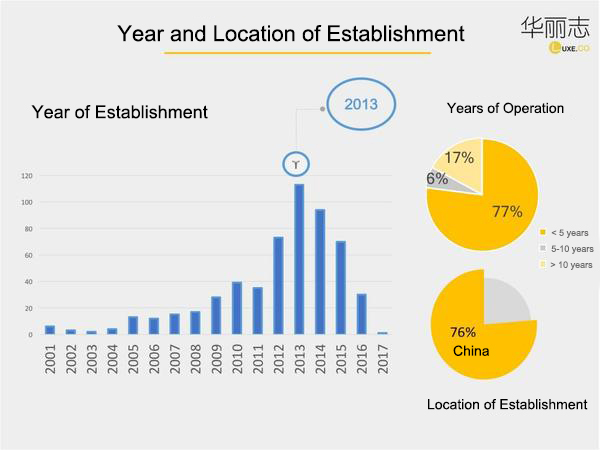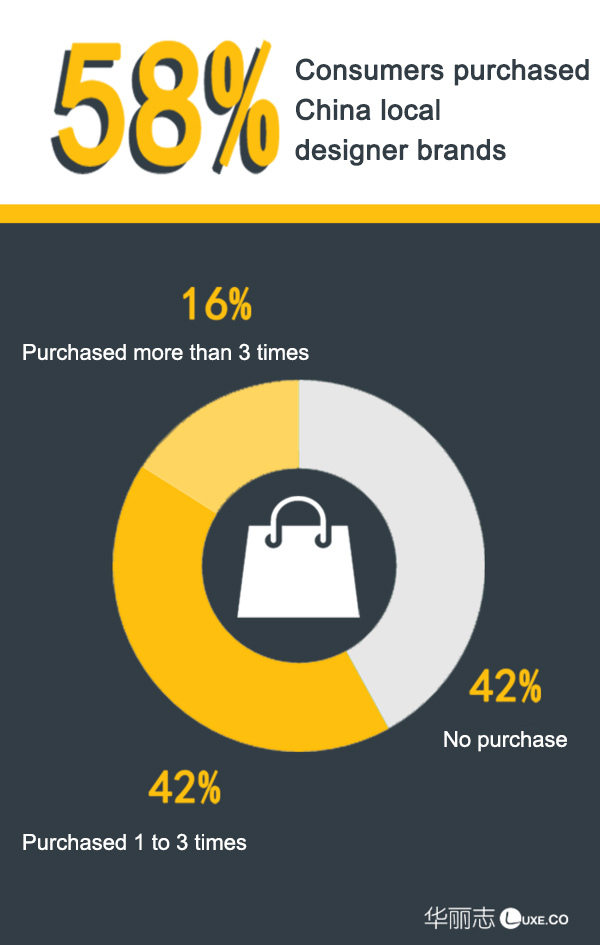How to Grow an Independent Fashion Designer Brand in China?
July 27,2017
Luxe.Co released the exclusive report, "China Independent Designer Brand Report (1st Edition)" in 2017. Alicia Yu, the founder of Luxe.Co shared her insights and Luxe.Coтs in-depth researchТ with Beijing News and CondУЉ Nast Center of Fashion & Design. She outlined howТ independent designer brands evolve fromТ тsmall but beautifulт start-ups intoТ successful fashion enterprises, and highlighted the challengesТ these brands would encounter along the journey.

Luxe.Co started establishing the database for China independent designer brands since 2015, including 651 designers and 581 brands currently.Т "China Independent Designer Brand Report" analyzed the development of these brands covering designers, brands, social media presence, distribution channels and others.
Over the past few years, China independent designer brands have been booming and becoming a non-neglectable force in the China fashion industry. According to the report, China designer brands emerged from around 2005, andТ had its first boom in 2010, and second boom in 2013. Many designer brands were founded between 2008 and 2013.
 Т Source: China Independent Designer Brand Report (1st Edition)
Т Source: China Independent Designer Brand Report (1st Edition)
In order to make continuous progress while maintaining their brand identity, independent designer brands must evolve along the journey. Alicia shared her insights in key areas, including customers, products, supply chain, distribution, people, and particularly finance, to elaborate how these brands continue to grow from strength to strength.
- Customers
Chinese customers have gained greater purchasing power and experienced consumption upgrade in the past decade. Instead of homogeneous products, increasingly sophisticated customers prefer personalized details and design elements, and have the purchasing power for a better shopping experience. This provides substantial marketТ opportunities for independent designer brands. In "China Independent Designer Report", Luxe.Co completed a survey with 1816 middle-to-high-end consumers. 58% of them purchased China local designer brands in the past year.

Source: Luxe.Co China Fashion Consumption Survey Report 2017
- Products
Fashion products require constant updates and innovation. It is impossible to purely rely upon previous success. Many well-known designers said that they have rarely been on vacation. Brands release new collections season after seasonТ in order to maintain brand awareness and commercial success.
For independent designer brands, products are key to success. The market does not lack of products, but GOOD products. A good product is a combination of good design, quality, price, as well as an agile and reliable supply chain.
- Supply Chain
Alicia believes that for independent designer brands, immature supply chain is a vicious circle. Designer products usually have distinguished design elements. Small-lot production results in higher production cost and higher retail price. From the price point of view, they are at a disadvantage compared to mass market products.
There are many people working on improving the efficiency of the supply chain, including helping designers in design and merchandising, to better understand and respond to market and customer feedback.
- Distribution
The internet technology provides great opportunities for designers. Many designer brands enter the market through online channels with direct access to customers.


Source: Luxe.Co China Independent Designer Brand Report
However, online distribution channels require immense expertiseТ of start-up designer brands in terms of product mix, pricing, supply chain, cost of maintenance and so on. To open an individual brick-and-mortar store is sometimes beyond the capability for most independent designers. The boom of multi-brand stores and showrooms provides easy access to distribution channels for these brands.
Alicia points out that if designer brands rely solely on occasional limited sales through multi-brand stores, they will be restrained in brand promotion and sustainable development. In her view, designer brands need to explore distribution channels both online and offline, including building their own direct channel, i.e., open stores selectively. In this way,Т brands will be able to haveТ access to a broader market and to fully examine their business potentials.
Alicia believes that brands should select their distribution channels based on their product features, team strengths and the characteristics of each channel. The unit price through online channel is usually low, which does not match designer brandsт price range. However online channel is a great platform for marketing, in addition to its sales function. Online channel operation also requires expertise and execution. Brick-and-mortar stores are beneficial for brand image, but brands need to have full confidence in their capabilities in terms ofТ products, display and daily operation.
- People:
At the independent designer forum hosted by CondУЉ Nast Center of Fashion & Design, Alicia talked with a group of fashion entrepreneurs. The founder of a designer brand, who graduated from Istituto Marangoni inТ Italy, expressed her struggle with her role. People recommend her to transform her mind-set from a designer to a business person. However, she prefers to hire professionals to handle the business side.

AliciaТ points outТ that entrepreneurs need to understand the difference between a start-up and a mature company. In a big organization, everyone works inТ his/her specialty area. However, a start-up usually has limited resources. Entrepreneurs are required to handle everything by themselves, or to network and find professionals to build a team. Entrepreneurs may be experts in certain areas, but they are also required to study other disciplines including business.
With continuous multidisciplinary studies, entrepreneurs will accomplish a breakthrough from existing mind-set inherited in the industry. Brainstorming and cross-disciplinary thinking will assist brands comprehend a broader world and identify new opportunities. This is especially important, in the market with increasingly intense competition, to achieve continued innovation and breakthrough.
Building a core team is also challenging for designer brand entrepreneurs. Alicia points out two main options for early stage recruitment. Firstly, effective PR marketing initiatives attract talents to approach the start-ups.Т The second option is to attend related industry forums and activities to network with potential team members or partners.
- Finance
Finance is one of the biggest challenges encountered by independent designer brands. This is a difficult process. It usually takes new brands three to five years to achieve positive cash flow.
With the spotlightТ on fashion consumption, independent designer brands and related business models have attracted the interests of capital investment in China. In the international market, there are specialty early-stage funds focusing on fashion brands. But compared to the overall venture capital industry, the designer brand segment is still a relatively small area for investments. The long development period for fashion brands does not match the quick-return requirement for general venture capitals.
According to Luxe.Co data, there are 376 cases of domestic equity investment in the fashion and lifestyle areas, with a total amount of 35.1 billion yuan in 2016.Т Investments were mainly focused on angel and Series A stages. Popular investment areas were hotel and travel, food and beverage, creativity and entertainment, sports and fitness, and online platforms. Fashion brand investment was rather limited.
Alicia highlights that venture capitals pay special attention to the internet genes of fashion start-ups. They prefer brands with effective online marketing and distribution. By leveraging on online platforms, brands can quickly build brand awareness, acquire vast customer base and improve the conversion rate of purchase at low cost, particularly for those vertically integrated companies.
Financing Options
At the early stage,Т designer brandsТ should pay special attention to a healthy cash flow. They can accessТ angel investment through supply chain business partners and intensive users. Alicia lists the following financing options for fashion startups.
- Seed equity investment or contribution from family, friends and intensive users
- Supply chain finance or equity investment from down-stream and/orТ up-stream business partners, i.e., suppliers or distributors
- Equity investment from professional angel investors, venture capitals, private equity funds, large conglomerates and financial markets
- Supply chain finance or loans from banks and other financial institutions, which is particularly lacking in the current China market environment
- Industry support funding from government or industrial organizations
Many parties in the supply chain (for example, manufacturers) are willing to participate in deeper cooperation or equity investment with familiar designer brands at their early stage of the development. Alicia believes that designer brands cooperating with down-stream or up-stream business partners at their early or medium stage, would be a more attractive financing option.
Alicia also highlights that brands must fully understand the cost when introducing equity investors, including possibilities of losing control in shares and decision-making. While investors can be demanding, Alicia encourages brands to be realistic and well-prepared with clear business plans, practical financial forecasts, operational strategic solutions and a forward-looking vision of development. Timing is also important. The optimal stage to engage with investors is when brands already reach a certain scale. By leveraging on investments, brands can take a quantum leap.
In terms of choosing investors, Alicia thinks that brands must understand their own requirements and have a clear development plan. They should evaluate potential investors objectively, considering risks, returns and preferences.Т As well,Т brands should avoid unrealistic expectations. Alicia highlights the importance of business plans. She believes that rational investors may not expect brands to implement all business plans written on paper, but they will evaluate brandsт intensive thinking process on the business. Adopting a reasonable business model will reduce risks and increase the chance of success.
In conclusion, successful fashionТ brands usually undergo a development period of 5 to 10 years from its establishment. Alicia believes that the next few years will be a blooming period for China independent designer brands.
| Chinese reporter: Ruoyu Zhu












Comments